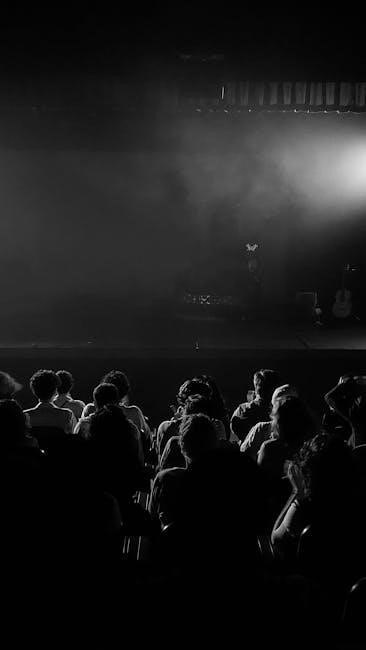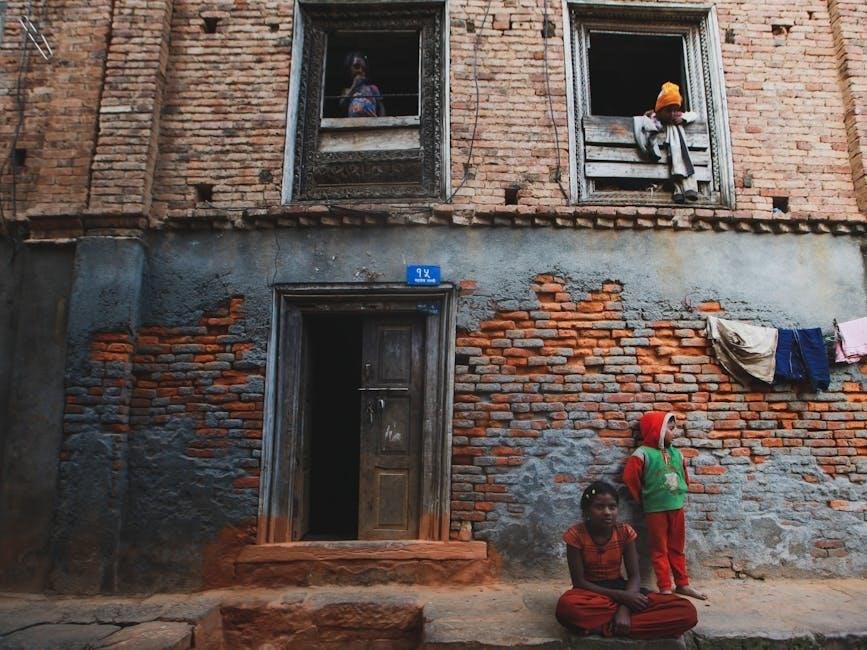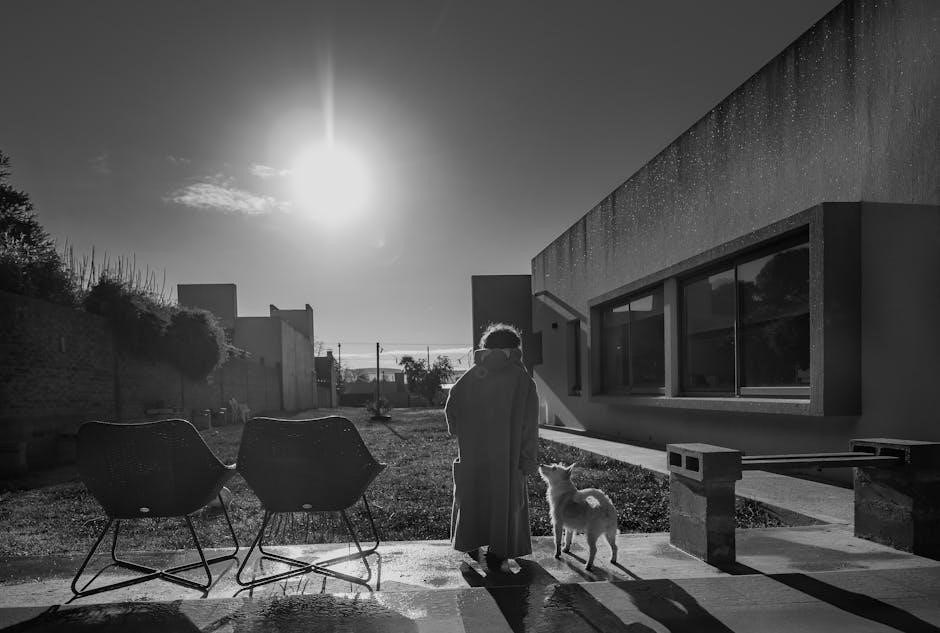Samuel Beckett’s Waiting for Godot is a groundbreaking tragicomedy exploring existential themes through Vladimir and Estragon’s endless wait for the elusive Godot. Its PDF availability has made this 20th-century theater cornerstone accessible globally, sparking enduring philosophical debates.
Overview of Samuel Beckett’s Play
Samuel Beckett’s Waiting for Godot is a two-act play that revolves around the endless waiting of two characters, Vladimir and Estragon, for someone named Godot, who never arrives. The play, written between 1948 and 1949, is a cornerstone of 20th-century theater, blending existentialism and absurdism. Its minimalist setting—a country road and a tree—reflects the characters’ existential limbo. The dialogue is circular, with recurring themes of time, memory, and the futility of human existence. Beckett’s unique style challenges traditional narrative structures, leaving audiences to interpret the meaning of Godot and the characters’ plight. The play’s ambiguity has sparked countless debates, solidifying its place as a masterpiece of modern literature and theater.
Historical Context and Background
Waiting for Godot was written by Samuel Beckett between October 1948 and January 1949, with its premiere on January 5, 1953. Rooted in post-World War II existentialism, the play reflects the era’s philosophical turmoil and search for meaning. Beckett’s experiences during the war, including his involvement in the French Resistance, deeply influenced his exploration of absurdism. The play’s minimalist setting and lack of traditional narrative were revolutionary, challenging conventional theater norms. Its premiere at Théâtre de Babylone in Paris marked a turning point in modern drama, sparking controversy and acclaim; The play’s historical significance lies in its reflection of the existential crisis of the 20th century, making it a cornerstone of absurdist literature and theater.
Significance of the Title “Waiting for Godot”

The title Waiting for Godot encapsulates the play’s central theme of existential anticipation and uncertainty. Godot, the elusive figure, symbolizes the unknown, divine, or unattainable, sparking interpretations as a metaphor for God or life’s meaning. Beckett denied that Godot represented God, leaving the character’s identity ambiguous. The title reflects the human condition of waiting for something that may never arrive, highlighting the absurdity of existence. This enigmatic title has become iconic, symbolizing the search for meaning in a seemingly indifferent world. Its simplicity belies profound philosophical depth, making it a cornerstone of absurdist philosophy and a focal point of critical analysis in modern literature and theater.

Plot and Structure of “Waiting for Godot”
The play follows Vladimir and Estragon as they wait endlessly for Godot on a desolate road. Structured in two acts, it explores themes of time, existence, and futility through their interactions and encounters with Pozzo, Lucky, and a mysterious boy. The cyclical nature of their waiting underscores the absurdity of their situation, leaving audiences questioning the meaning of their relentless anticipation.
Act 1 Summary and Key Events
Act 1 of Waiting for Godot introduces Vladimir and Estragon, two vagrants trapped in an endless cycle of waiting for the elusive Godot. The act opens with Estragon struggling to remove his boot, symbolizing their existential struggles. They discuss suicide and their dependence on each other, highlighting their desperation. The arrival of Pozzo and Lucky disrupts their monotony, showcasing Pozzo’s tyrannical control over Lucky. Lucky’s nonsensical monologue, triggered by Pozzo’s whip, reflects the absurdity of their situation. A boy appears, delivering a message that Godot will not come today but promises to return tomorrow. The act ends with Vladimir and Estragon resolving to leave but remaining stationary, emphasizing their inertia and the futility of their wait.
Act 2 Summary and Key Events
Act 2 of Waiting for Godot begins the next day, with Vladimir and Estragon still waiting for Godot. The tree now has leaves, symbolizing time’s passage. Pozzo returns, now blind, and Lucky, now mute, further emphasizing the characters’ deteriorating conditions. The boy reappears, delivering the same message that Godot will not come today but promises to return tomorrow. Vladimir and Estragon consider hanging themselves but lack the resolve. They decide to leave but remain stationary, trapped in their endless cycle of waiting. Act 2 underscores the futility of their existence, as they confront the reality of their situation with no resolution in sight.
The Absence of Godot: A Central Theme
The absence of Godot is the cornerstone of Samuel Beckett’s Waiting for Godot, symbolizing the unknown and the unattainable. Godot’s nonappearance underscores the futility of waiting and the lack of meaning in an indifferent universe. This enigmatic figure, who is never seen or heard, represents the elusive nature of hope and expectation. Vladimir and Estragon’s endless wait for Godot mirrors the human condition, where individuals often find themselves in limbo, searching for answers that never arrive. The absence of Godot challenges the characters—and the audience—to confront the reality of uncertainty and the limits of human understanding, creating a profound exploration of existential despair and the search for meaning.

Major Themes in “Waiting for Godot”
Existentialism, absurdism, and the cyclical nature of time are central themes, reflecting humanity’s search for meaning in a seemingly meaningless world through Vladimir and Estragon’s endless wait.
Existentialism and the Meaning of Life
Samuel Beckett’s Waiting for Godot delves deeply into existentialist philosophy, exploring the human condition and the search for life’s meaning. Vladimir and Estragon’s endless wait for Godot symbolizes humanity’s futile pursuit of purpose in an indifferent universe. Their dialogue, filled with uncertainty and absurdity, reflects existentialist ideas of freedom, responsibility, and the inevitability of suffering. The play challenges traditional notions of meaning, presenting a world where rational explanations fail, and existence is inherently ambiguous. Through their struggles, Beckett illustrates the absurdity of seeking definitive answers in a chaotic world, leaving audiences to grapple with the profound question of how to find meaning in the absence of certainty. This theme resonates universally, making Waiting for Godot a cornerstone of existentialist literature.
The Theater of the Absurd
Waiting for Godot is a seminal work in the Theater of the Absurd, a movement that rejects traditional dramatic structures and rational storytelling. The play’s cyclical dialogue, lack of plot progression, and ambiguous characters exemplify the absurd. Vladimir and Estragon’s repetitive actions and futile waiting for Godot illustrate the meaninglessness of human existence. Beckett employs absurdity to convey the impossibility of finding logical answers to life’s mysteries. The play’s refusal to conform to conventional theater norms challenges audiences to embrace ambiguity and the illogical, making it a defining piece of absurdist literature. Through its absurd elements, Waiting for Godot critiques societal norms and conventional storytelling, offering a profound reflection on human existence.
Time and Its Cyclical Nature
In Waiting for Godot, time is depicted as cyclical and meaningless, with Vladimir and Estragon trapped in an endless loop of waiting. The play’s structure, divided into two acts with identical settings, reinforces this theme. The characters’ repetitive actions, such as Estragon’s struggle with his boots and their constant conversations, highlight the futility of their existence. Beckett uses time’s cyclical nature to emphasize the absurdity of waiting for something that never arrives. The absence of a clear timeline or progression underscores the idea that time lacks purpose in their world. This cyclical portrayal of time reflects the broader existential theme of human existence as inherently futile and without direction, leaving the characters, and the audience, in a state of perpetual limbo.

Key Characters and Their Roles
Vladimir and Estragon are central figures, embodying existential despair. Pozzo and Lucky represent master-slave dynamics, while the Boy serves as a mysterious informant about Godot’s absence.
Vladimir (Didi) and Estragon (Gogo)
Vladimir and Estragon are the core characters, trapped in an endless cycle of waiting for Godot. Vladimir, often called Didi, is the more philosophical and hopeful of the two, while Estragon, or Gogo, is pragmatic and pessimistic. Their relationship is deeply intertwined, with Vladimir offering emotional support and Estragon focusing on physical survival. Despite their differences, they rely on each other to endure the monotony and absurdity of their existence. Their interactions reveal a profound bond, oscillating between frustration and affection. Together, they embody the human condition, struggling to find meaning in a seemingly meaningless world. Their dynamic drives the play’s exploration of existentialism and the absurd, making them iconic figures in modern theater.
Pozzo and Lucky: Their Significance
Pozzo and Lucky are pivotal characters in Waiting for Godot, embodying master-slave dynamics and existential despair. Pozzo, a self-proclaimed leader, wields a whip and rope, symbolizing control and domination, while Lucky, his submissive counterpart, carries burdens both physical and metaphorical. Their interactions highlight power imbalances and the absurdity of hierarchy. Lucky’s famous, incoherent monologue underscores the futility of language and meaning in a chaotic world. Pozzo’s eventual blindness and Lucky’s silence in Act 2 mirror the play’s themes of decline and the cyclical nature of time. Together, they represent humanity’s struggle for purpose and the inevitability of loss, deepening the play’s exploration of the absurd.
The Boy and His Role in the Play
The Boy is a minor yet symbolically significant character in Waiting for Godot, appearing in both acts to deliver sparse, enigmatic messages. His role as a messenger, claiming to have been sent by Godot, adds layers of ambiguity and mystery. Despite his youth and seeming innocence, the Boy’s interactions with Vladimir and Estragon reveal a deeper existential futility. His presence highlights the theme of waiting and the cyclical nature of time, as he appears unchanged across acts. The Boy’s minimal dialogue and consistent denial of seeing Godot underscore the play’s central themes of anticipation and disillusionment, leaving the audience questioning his purpose and connection to the elusive Godot.

Symbolism in “Waiting for Godot”
Waiting for Godot is rich in symbolic elements, with the tree, road, and hats representing existential themes. These symbols convey the absurdity of life and the futility of waiting, enhancing the play’s philosophical depth and universal resonance.
The Tree as a Symbol
The tree in Waiting for Godot is a central symbol, appearing in both acts. Bare in Act 1 and leafy in Act 2, it signifies the passage of time and the futility of waiting. It underscores existential themes, emphasizing life’s absurdity and the absence of meaningful change. The tree’s endurance contrasts with the characters’ stagnation, symbolizing the human condition’s complexity. Its presence serves as a silent witness to their endless wait, devoid of shade or fruit, mirroring their barren existence. This duality reflects the play’s exploration of hope and despair, making the tree a poignant emblem of the characters’ plight.
The Road and Its Implications
The road in Waiting for Godot serves as a timeless and universal symbol, representing the characters’ existential journey. It is a place of waiting, ambiguity, and uncertainty, devoid of clear direction or purpose. The road’s emptiness mirrors the characters’ lack of progress, emphasizing the futility of their wait for Godot. Its presence underscores themes of isolation and the search for meaning in an indifferent world. The road also symbolizes the passage of time, as characters repeatedly return to it, highlighting the cyclical nature of their existence. It remains a central element, reinforcing the play’s exploration of human existence, hope, and despair, while leaving interpretations of its significance open to the audience.
The Hats and Their Symbolic Meaning
The hats in Waiting for Godot carry significant symbolic weight, reflecting the characters’ identities and existential struggles. Vladimir and Estragon’s hats serve as fragile markers of selfhood, offering a sense of purpose amidst their uncertainty. When Lucky’s hat is removed, it symbolizes his loss of autonomy and dignity. Pozzo’s hat, adorned with feathers, signifies his self-proclaimed superiority, contrasting with his eventual blindness and vulnerability. The hats also represent the transience of power and status, as Pozzo’s dominance over Lucky crumbles. Their presence underscores themes of appearance versus reality, highlighting how external symbols can both define and deceive. Through the hats, Beckett critiques societal hierarchies and the fleeting nature of human pretensions.

Reception and Legacy of the Play
Waiting for Godot sparked controversy upon its debut but became a cornerstone of modern theater, influencing countless works and igniting philosophical debates about existentialism and absurdism.
Initial Reception and Controversies
When Waiting for Godot premiered in 1953, it faced significant controversy due to its unconventional structure and lack of a traditional narrative. Audiences and critics were divided, with some praising its bold departure from traditional theater while others found it perplexing or even offensive. The play’s absurdist elements, particularly its focus on the meaningless wait for a character who never arrives, challenged audience expectations and sparked heated debates. Despite initial confusion, the play gradually gained recognition as a revolutionary work, eventually becoming a cornerstone of 20th-century theater and cementing Beckett’s reputation as a pioneer of the Theater of the Absurd.
Cultural Impact and Influence
Waiting for Godot has left an indelible mark on modern culture, inspiring countless adaptations, parodies, and references in literature, film, and art. Its exploration of existentialism and absurdism resonated deeply, influencing playwrights like Harold Pinter and David Mamet. The play’s themes of uncertainty and waiting have become metaphors for life’s ambiguities, appearing in works like The Simpsons and Seinfeld. Its influence extends to music and philosophy, with artists drawing parallels to its existential queries. The play’s iconic imagery, such as the tree and the road, has become symbolic in popular culture, representing existential longing. Its impact continues to grow, making it a timeless reflection of humanity’s search for meaning in an uncertain world.
Academic and Critical Analysis
Samuel Beckett’s Waiting for Godot has been extensively analyzed in academic circles, with scholars exploring its existential themes, absurdism, and philosophical undertones. The play’s ambiguity, particularly regarding the identity and purpose of Godot, has sparked countless interpretations, ranging from theological to psychoanalytic. Critics often highlight Beckett’s minimalist dialogue and cyclical structure, which mirror the futility of human existence. The play’s refusal to provide clear answers has led to it being seen as a reflection of post-war existential angst and the absurdity of life. Academic studies frequently examine the interplay between Vladimir and Estragon, symbolizing the human condition’s complexity. The play’s influence on modern literary theory and its challenges to traditional narrative structures remain central to scholarly discourse, cementing its status as a seminal work in 20th-century literature.

Performances and Adaptations
Notable stage productions and film adaptations of Waiting for Godot have reimagined Beckett’s timeless themes, offering fresh interpretations while maintaining the play’s existential core.
Notable Stage Productions
Since its 1953 premiere at Paris’s Théâtre de Babylone, Waiting for Godot has seen countless stage productions worldwide. A groundbreaking 1955 production directed by Peter Hall at London’s Arts Theatre introduced Beckett’s work to English audiences. In 1964, the Royal Shakespeare Company staged a memorable version, solidifying the play’s reputation. More recently, a 2013 production by the Residenztheater München explored modern interpretations, blending traditional themes with contemporary aesthetics. These adaptations highlight the play’s versatility and enduring relevance, offering fresh perspectives on Beckett’s existential masterpiece while remaining true to its core themes of waiting and uncertainty.
Film and Radio Adaptations
Waiting for Godot has been adapted into various film and radio productions, each offering unique interpretations. A notable 2001 film adaptation starred Johnny Depp and Barry Humphries, blending visual storytelling with Beckett’s dialogue. Radio adaptations, such as BBC Radio 4’s 2010 production, emphasized the play’s auditory nuances. These adaptations have expanded the reach of Beckett’s work, making it accessible to new audiences while preserving its existential essence. They provide fresh perspectives on the themes of waiting and ambiguity, ensuring the play’s relevance across different media platforms.

Modern Interpretations and Reimaginings
Modern interpretations of Waiting for Godot continue to evolve, with artists reimagining Beckett’s classic in innovative ways. Recent stage productions have incorporated multimedia elements, blending traditional theater with digital visuals. Some directors have set the play in contemporary urban landscapes, drawing parallels between the characters’ existential struggles and modern societal challenges. Additionally, there have been gender-swapped performances and multicultural casts, offering fresh perspectives on Beckett’s themes. These reinterpretations highlight the timeless relevance of Waiting for Godot, proving its adaptability across cultures and mediums. By exploring new artistic approaches, these modern adaptations ensure the play remains a vital part of contemporary theatrical discourse.

Resources and Accessibility
Waiting for Godot is widely available in PDF format, along with study guides and educational resources, making it accessible for readers and scholars worldwide to explore Beckett’s masterpiece.
Availability of “Waiting for Godot” in PDF Format
Waiting for Godot is readily accessible in PDF format, allowing readers to download and study Samuel Beckett’s iconic play conveniently. This digital version preserves the original’s integrity, enabling scholars and enthusiasts to engage with its profound themes and complex characters. The PDF format ensures compatibility across various devices, making it a popular choice for educational purposes and personal reading. Its widespread availability has contributed to the play’s enduring influence, ensuring that Beckett’s exploration of existentialism and absurdism remains within easy reach for global audiences.
Study Guides and Educational Resources
Various study guides and educational resources are available to deepen understanding of Waiting for Godot. These include detailed PDF analyses, character studies, and thematic breakdowns, offering insights into Beckett’s existential themes. Online platforms provide discussion forums, critical essays, and lecture notes, aiding students and scholars. Many resources focus on the play’s absurdism, symbolism, and philosophical undertones. For instance, guides often explore Lucky’s monologue, the tree’s significance, and the cyclical nature of time. Educators and readers can access these materials to enhance their analysis and appreciation of Beckett’s work. Such resources are invaluable for academic and personal exploration of the play.
Online Discussions and Forums
Online discussions and forums dedicated to Waiting for Godot provide vibrant spaces for analysis and debate. Fans, scholars, and students share interpretations of the play’s themes, such as existentialism and absurdism. Many forums highlight the significance of Lucky’s monologue and the symbolism of the tree. Users often discuss the play’s PDF versions, sharing links to free downloads and study guides. These platforms also host critiques of stage productions and adaptations, offering diverse perspectives on Beckett’s work. Online communities foster collaboration, enabling participants to explore complex ideas and exchange insights. Such forums are invaluable for those seeking deeper understanding of the play’s philosophical and theatrical dimensions.
